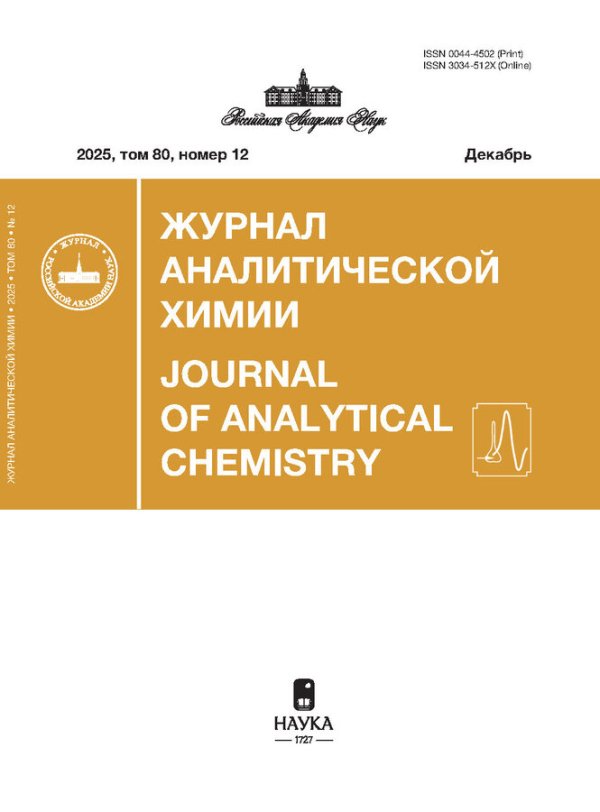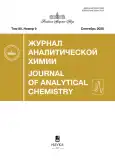Detection of melittin – a characteristic peptide of bee venom – in soft medicinal forms by high-resolution chromatography-mass spectrometry
- Authors: Vokuev M.F.1, Oprunenko A.Y.1, Frolova A.V.1, Baygildiev T.M.2,3, Rodin I.A.1,3
-
Affiliations:
- Faculty of Chemistry, Lomonosov Moscow State University
- Frumkin Institute of Physical Chemistry and Electrochemistry, Russian Academy of Sciences
- MIREA – Russian Technological University (Lomonosov Institute of Fine Chemical Technologies)
- Issue: Vol 80, No 9 (2025)
- Pages: 987-995
- Section: ORIGINAL ARTICLES
- Submitted: 10.09.2025
- URL: https://bakhtiniada.ru/0044-4502/article/view/308733
- DOI: https://doi.org/10.31857/S0044450225090071
- EDN: https://elibrary.ru/bufljq
- ID: 308733
Cite item
Abstract
About the authors
M. F. Vokuev
Faculty of Chemistry, Lomonosov Moscow State University
Email: vokuevmihail11@gmail.com
Moscow, Russia
A. Y. Oprunenko
Faculty of Chemistry, Lomonosov Moscow State UniversityMoscow, Russia
A. V. Frolova
Faculty of Chemistry, Lomonosov Moscow State UniversityMoscow, Russia
T. M. Baygildiev
Frumkin Institute of Physical Chemistry and Electrochemistry, Russian Academy of Sciences; MIREA – Russian Technological University (Lomonosov Institute of Fine Chemical Technologies)Moscow, Russia; Moscow, Russia
I. A. Rodin
Faculty of Chemistry, Lomonosov Moscow State University; MIREA – Russian Technological University (Lomonosov Institute of Fine Chemical Technologies)Moscow, Russia; Moscow, Russia
References
- Habermann E. Bee and wasp venoms: the biochemistry and pharmacology of their peptides and enzymes are reviewed // Science. 1972. V. 177. P. 316.
- Banks B.E.L., Shipolini R.A. Chemistry and Pharmacology of Honey-Bee Venom. Academic Press, 1986. P. 329.
- Khalil A., Elesawy B.H., Ali T.M., Ahmed O.M. Bee venom: From venom to drug // Molecules. 2021. V. 26. № 16. P. 4941.
- Lee J.D., Park H.J., Chae Y., Lim S. An overview of bee venom acupuncture in the treatment of arthritis // Evidence-Based Complem. Altern. Med. 2005. V. 2. № 1. P. 81.
- Kim C.M. Bee venom therapy for arthritis // Rhumatologie. 1989. V. 41. № 3. P. 69.
- Pamukcu B., Lip G.Y., Shantsila E. The nuclear factor–kappa B pathway in atherosclerosis: A potential therapeutic target for atherothrombotic vascular disease // Thrombosis Res. 2011. V. 128. № 2. P. 118.
- Son, D.J., Lee, J.W., Lee, Y.H., Song, H.S., Lee, C.K., Hong, J.T. Therapeutic application of anti-arthritis, pain-releasing, and anti-cancer effects of bee venom and its constituent compounds // Pharmacol. Ther. 2007. V. 115. № 2. P. 252.
- Hauser R.A., Daguio, M., Wester D., Hauser M., Kirchman A., Skinkis C. Bee-venom therapy for treating multiple sclerosis: A clinical trial // Altern. Complem. Ther. 2001. V. 7. № 1. P. 40.
- Gauldie J., Hanson J.M., Shipolini R.A., Vernon, C.A. The structures of some peptides from bee venom // Eur. J. Biochem. 1978. V. 83. № 2. P. 411.
- Banks B.E., Dempsey C.E., Pearce F.L., Vernon C.A., Wholley T.E. New methods of isolating bee venom peptides // Anal. Biochem. 1981. P. 116. № 1. P. 50.
- Follenius-Wund A., Mely Y., Gerard D. Spectroscopic evidence of two melittin molecules bound to Ca2+-calmodulin // Biochem. Int. 1987. V. 15. № 4. P. 829.
- Flach C.R., Prendergast F.G., Mendelsohn, R. Infrared reflection-absorption of melittin interaction with phospholipid monolayers at the air/water interface // Biophys. J. 1996. V. 70. № 1. P. 542.
- Kaszycki P., Wasylewski Z. Fluorescence-quenching-resolved spectra of melittin in lipid bilayers // Biochim. Biophys. Acta: Protein Struct. Mol. Enzymol. 1990. V. 1040. № 3. P. 341.
- Ramirez L., Shekhtman A., Pande J. Nuclear magnetic resonance-based structural characterization and backbone dynamics of recombinant bee venom melittin // Biochemistry. 2018. V. 57. № 19. P. 2778.
- Brown L.R., Braun W., Kumar A., Wüthrich K. High resolution nuclear magnetic resonance studies of the conformation and orientation of melittin bound to a lipid-water interface // Biophys. J. 1982. V. 37. № 1. P. 320.
- Bradrick T.D., Freire E., Georghiou S. A high-sensitivity differential scanning calorimetric study of the interaction of melittin with dipalmitoylphosphatidylcholine fused unilamellar vesicles // Biochim. Biophys. Acta: Biomembranes. 1989. V. 982. № 1. P. 97.
- Pacakova V., Štulík K., Hau P.T., Jelinek I., Vinš I., Sýkora D. Comparison of high-performance liquid chromatography and capillary electrophoresis for the determination of some bee venom components // J. Chromatogr. A. 1995. V. 700. № 1-2. P. 188.
- Szókán G.Y., Horvath J., Almas M., Saftics G.Y., Palocz A. Liquid chromatographic analysis and separation of polypeptide components from honeybee venoms // J. Liq. Chromatogr. 1994. V. 17. № 16. P. 3335.
- Räder K., Wildfeuer A., Wintersberger F., Bossinger P., Mücke H.W. Characterization of bee venom and its main components by high performance liquid chromatography // J. Chromatogr. 1987. V. 408. P. 345.
- Rybak-Chmielewska H., Szczêsna T. HPLC study of chemical composition of honeybee (Apis mellifera L.) venom // J. Apicult. Sci. 2004. V. 48. № 2. P. 106.
- Pattanaargson S., Roboz J. Determination of hyaluronidase activity in venoms using capillary electrophoresis // Toxicon. 1996. V. 34. № 10. P. 1111.
- Pak S.C. Chemical composition of bee venom / Bee Products – Chemical and Biological Properties. Springer, 2017. P. 282.
- Raghuraman H., Chattopadhyay A. Melittin: A membrane-active peptide with diverse functions // Biosci. Rep. 2007. V. 27. № 4-5. P. 190.
- Yakobson B.A. The monitoring of possible biological and chemical contaminants in bee products / Bee Products: Properties, Applications, and Apitherapy / Eds. Mizrahi A., Lensky Y. New York: Plenum, 1997. P. 225.
- Kokot Z.J., Matysiak J. Simultaneous determination of major constituents of honeybee venom by LC-DAD // Chromatographia. 2009. V. 69. P. 1403.
- Zhou J., Zhao J., Zhang S., Shen J., Qi Y., Xue X., Li Yi, Wu L., Zhang J., Chen F., Chen L. Quantification of melittin and apamin in bee venom lyophilized powder from Apis mellifera by liquid chromatography–diode array detector–tandem mass spectrometry // Anal. Biochem. 2010. V. 404. № 2. P. 175.
- Akhmerova D.I., Stavrianidi A.N., Rodin I.A., Shpigun, O.A. Application of high-performance liquid chromatography-tandem mass spectrometry for detection of melittin, a characteristic peptide of bee venom. // Inorg. Mater. 2015. V. 51. P. 1436.
- Flanjak I., Primorac L., Stokanović M.C., Puškadija Z., Rajs B.B., Kovačić M. Melittin stability in honey bee venom under different storage conditions measured with RP-HPLC-PDA method / 45th Croatian and 5th Int. Symp. on Agriculture “Fisheries, Game Management and Beekeeping”, 2021. P. 470.
- Dong J., Ying B., Huang S., Ma S., Long P., Tu X., Miao X. High-performance liquid chromatography combined with intrinsic fluorescence detection to analyse melittin in individual honeybee (Apis mellifera) venom sac // J. Chromatogr. B. 2015. V. 1002. P. 141.
- Matysiak J., Schmelzer C.E., Neubert R.H., Kokot Z.J. Characterization of honeybee venom by MALDI-TOF and nanoESI-QqTOF mass spectrometry // J. Pharm. Biomed. Anal. 2011. V. 54. № 2. P. 275.
- Denisov E., Damoc E., Lange O., Makarov A. Orbitrap mass spectrometry with resolving powers above 1.000.000 // Int. J. Mass Spectrom. 2012. V. 325 P. 83.
Supplementary files











